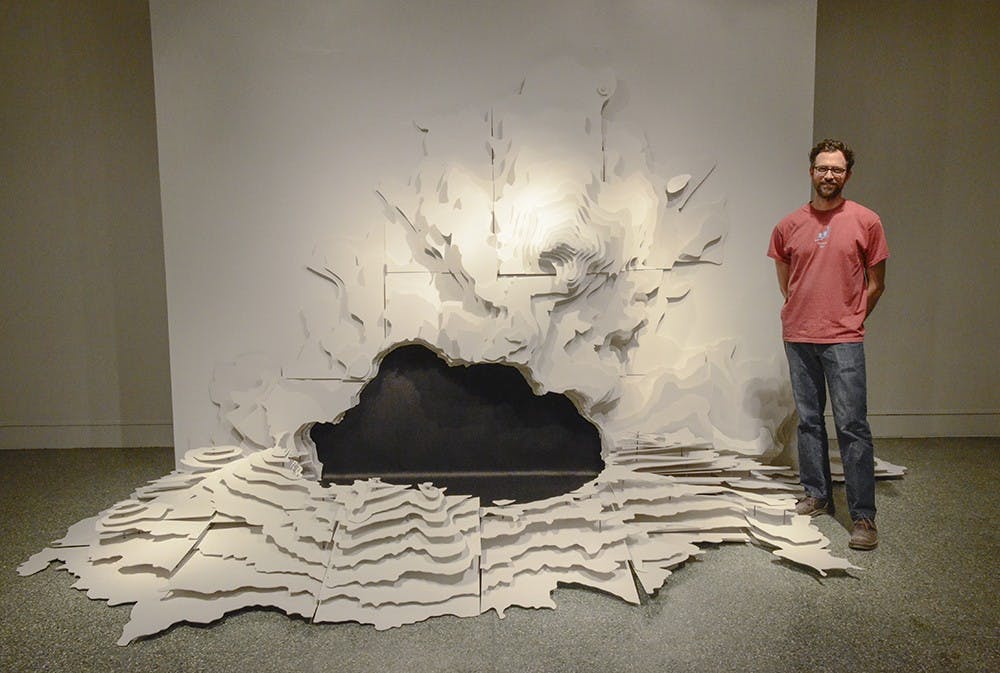On Wednesday, the Grunwald Gallery of Art opened up their final display of MFA thesis exhibits across genres, including works from printmaking, ceramics and textiles, among others.
Tai Rogers, a graduate student working for his MFA in ceramics, displayed a group of sculptural pieces made of materials such as wood, steel and artificial lighting. Topography, maps and cartography were the ?focus of inspiration.
“My objects become abstracted because of the removal of specifics like names and numbers,” Rogers said. “They become these aesthetic objects that are just about the lines and the spaces that they create.”
The show, titled “Fabricated Landscapes,” includes large-scale pieces inspired by actual locations on maps, but are given a whimsical makeover.
“I’m creating these spaces that are fantastical and imaginary,” Rogers said. “In a sense, they’re creating their own worlds.”
The pieces, Rogers said, follow a similar trajectory he established throughout his time as an artist at IU.
“I’ve been investigating ideas related to identity and navigation all through the avenue of understanding our place in the world and such,” Rogers said.
“It’s not particularly new, there are new elements to them; there are new kinds of techniques that I’ve explored.”
Rogers said the inciting event for this inspirational path came during his time in the Peace Corps after undergraduate school.
Stationed on a coffee farm in Jamaica, Rogers was not in the United States during the 9/11 attacks on the World Trade Center.
“My whole sense of the world was shifted, so I started really searching for understanding my place,” Rogers said. “I started with the local, really understanding where I was living, which wasn’t on a map.”
After that, Rogers said he moved on to investigating other locations in the quest to combat the sense of dislocation he felt being so far away during such a major cultural shift.
From Mosul, Iraq, to Washington, Rogers said, all land looks the same when you strip away the objects on top. Through his work, he has been able to become more at peace with where he has been and the universality of a place.
“The land becomes this sense of, it blends everything together, people ?become one, in a way,” Rogers said. “For me, it allows me to explore, look at places where I want to go or where I’ve been.”
In the adjacent gallery is the work of Adam Rake, a MFA printmaker. Rake said he decided to try an art form not directly related but very similar to printmaking for his MFA thesis.
Rake’s work is a collection of walls, or small sections of manufactured wall, designed to show how the wall itself is a reflection of both current and historical cultures.
“There’s some kind of almost ancestral memory to the walls,” Rake said. “I’m taking that as a source of kind of aesthetic departure, I’m trying to apply some of that to reflections on where I think culture is today and kind of elegize a sense of almost a cultural absence.”
Though not a print on paper, Rake said the two art forms have much in common in terms of something physical standing between a person and the world around them.
“There’s something in printmaking where you have to rely on a matrix, you have to rely on an intermediary before you get to the work itself, which is very similar to how I understand the wall,” Rake said. “It’s this intermediary between time and people.”
The show’s title, “What Remains?” is a question Rake said permeates a lot of his past and present work. He wants to create images of beauty that outlast the doubts of those who work against it.
It is a question, Rake said, all of us face in our day-to-day lives, and he hopes to capture that curiosity and optimism through the walls installed at the gallery.
“I’m trying to get at that in these works, the sense of frustration, of wanting to be hopeful and being genuinely optimistic about life but feeling this overall sense of not being able to hold onto anything for very long before it escapes us,” Rake said.
Rake said the biggest takeaway from his time in the MFA program is a sense of community and companionship with his fellow Bloomington artists, one he does not think would have been so accessible ?elsewhere.
He added the positive relationships of the artists as well as frequent shows at venues such as the Grunwald give many opportunities to check up on friends and celebrate good work.
“I’ve really valued that, because we’ll take that with us once we get out of school, and we’re all trying to figure out what our next show’s going to be, what our next job’s going to be, what positions are open,” Rake said. “That network will really hold here because it was genuine.”






